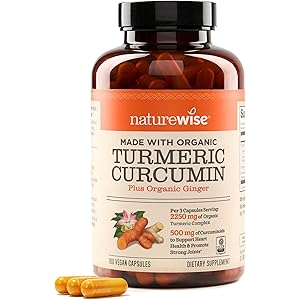NatureWise Curcumin Turmeric 2250mg - 95% Curcuminoids & BioPerine Black Pepper Extract for Advanced Absorption - Daily Joint and Immune Health Support - Vegan, Non-GMO, 180 Count[60-Day Supply]
$21.49 (as of October 27, 2025 06:27 GMT +00:00 - More infoProduct prices and availability are accurate as of the date/time indicated and are subject to change. Any price and availability information displayed on [relevant Amazon Site(s), as applicable] at the time of purchase will apply to the purchase of this product.)Understanding Recommended Dietary Allowance
The Recommended Dietary Allowance (RDA) is a crucial guideline established to help individuals understand the optimal intake of essential nutrients. It serves as a benchmark for the daily intake levels of vitamins, minerals, and other nutrients necessary for maintaining good health. The RDA is designed to meet the nutritional needs of nearly all healthy individuals in a specific age and gender group, ensuring that they receive adequate nutrition to support their overall well-being.
History of the Recommended Dietary Allowance
The concept of the Recommended Dietary Allowance was first introduced in the 1940s as part of the efforts to combat malnutrition and promote public health. Initially developed by the Food and Nutrition Board of the National Academy of Sciences, the RDA has evolved over the decades to reflect new scientific research and dietary trends. This evolution highlights the importance of adapting nutritional guidelines to meet the changing needs of the population.
Components of the Recommended Dietary Allowance
The RDA encompasses a variety of nutrients, including macronutrients like carbohydrates, proteins, and fats, as well as micronutrients such as vitamins and minerals. Each nutrient has its own specific RDA, which is determined based on factors such as age, gender, and life stage. For instance, the RDA for calcium differs for children, adults, and pregnant women, reflecting the varying needs for this vital mineral throughout different life stages.
How the Recommended Dietary Allowance is Determined
Determining the RDA involves extensive research and analysis of dietary intake data, health outcomes, and nutrient requirements. Experts in nutrition and health assess the amount of each nutrient that is necessary to prevent deficiency and promote optimal health. This process includes evaluating the average intake levels of the population and identifying the amounts that would meet the needs of 97-98% of individuals in a specific demographic group.
Importance of the Recommended Dietary Allowance
The RDA plays a vital role in public health by providing a framework for dietary recommendations and nutrition education. It helps individuals make informed choices about their diets, ensuring they consume adequate amounts of essential nutrients. Additionally, healthcare professionals use the RDA as a reference point when assessing patients’ nutritional status and developing dietary plans tailored to their specific needs.
Recommended Dietary Allowance vs. Adequate Intake
While the RDA provides a specific intake level for nutrients, there are instances where sufficient data is lacking to establish an RDA. In such cases, the Adequate Intake (AI) is used as an alternative. The AI is based on observed or experimentally determined estimates of nutrient intake by a group of healthy people. It serves as a guideline for individuals when an RDA cannot be determined, ensuring that they still have a target for nutrient intake.
Challenges in Meeting the Recommended Dietary Allowance
Many individuals struggle to meet the RDA for various nutrients due to dietary restrictions, lifestyle choices, or lack of access to nutritious foods. Factors such as busy schedules, economic constraints, and food availability can hinder one’s ability to consume a balanced diet rich in essential nutrients. Understanding these challenges is crucial for developing effective strategies to improve dietary habits and overall health.
Recommended Dietary Allowance and Supplementation
For those who find it difficult to meet their RDA through food alone, dietary supplements can be a valuable option. However, it is essential to approach supplementation with caution, as excessive intake of certain nutrients can lead to toxicity and adverse health effects. Consulting with a healthcare professional before starting any supplementation regimen is advisable to ensure safety and appropriateness based on individual health needs.
Future of the Recommended Dietary Allowance
As nutritional science continues to advance, the Recommended Dietary Allowance will likely undergo further revisions to reflect new findings and dietary patterns. Ongoing research into the role of nutrients in health and disease will inform updates to the RDA, ensuring that it remains a relevant and effective tool for promoting optimal nutrition and health across diverse populations.


